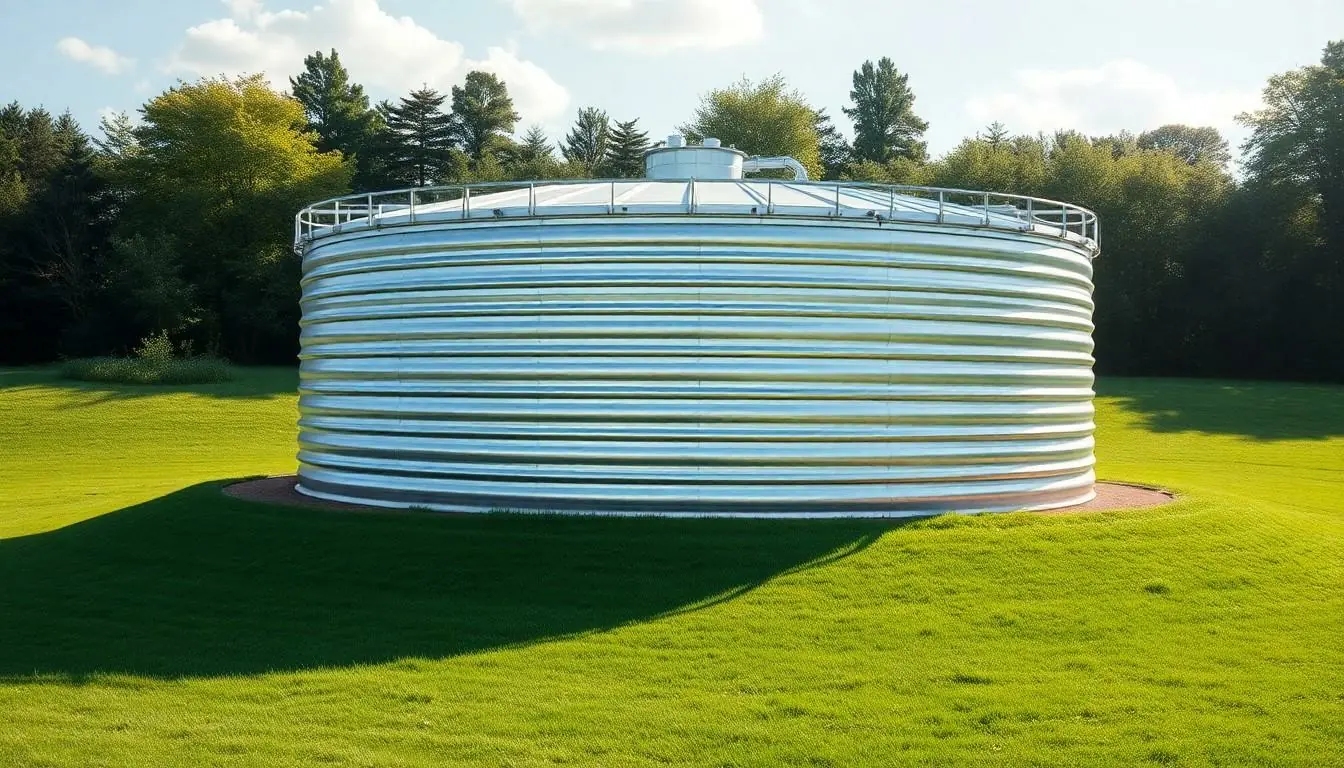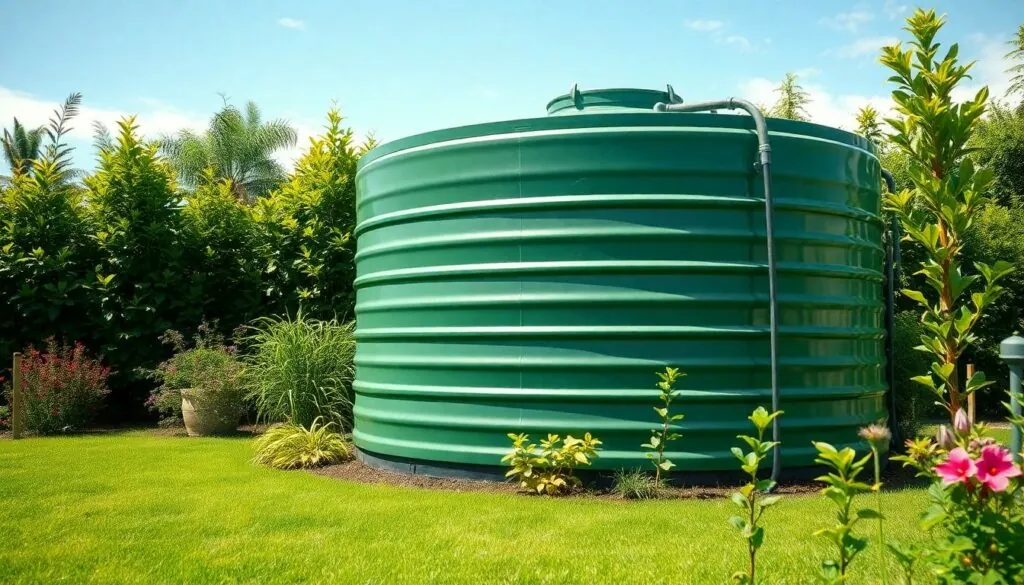Water is life, but storing it can feel like trying to catch a fish with your bare hands. With growing populations and unpredictable weather patterns, finding effective water storage solutions is more crucial than ever. Whether it’s for agricultural needs, emergency preparedness, or just keeping that backyard fountain flowing, the right storage method can make all the difference.
Table of Contents
ToggleOverview of Water Storage Solutions
Effective water storage solutions play a critical role in addressing the challenges posed by growing populations and unpredictable weather patterns. With increasing demand for water in agriculture, households, and emergency readiness, various storage options are now available. These options include tanks, cisterns, and reservoirs, each designed to accommodate specific needs.
Tanks stand out for smaller-scale water storage. Often made from materials like polyethylene or fiberglass, they provide durability and ease of installation. Cisterns, typically buried underground, offer high capacity and protect water from contamination. They serve as a great choice for rainwater harvesting systems.
Reservoirs tend to serve larger communities or agricultural needs. Their design allows for extensive water collection and storage. Many reservoirs integrate advanced filtration systems to ensure water quality, making them suitable for drinking and irrigation.
Fixed water storage solutions generally involve infrastructure. Examples include municipal water towers and agricultural ponds, both essential for sustaining communities and ecosystems. Mobile storage, on the other hand, includes collapsible water bladders and transportable tanks, offering flexibility for emergency situations.
The selection of the right storage solution hinges on individual requirements and environmental factors. Capacity, cost, and maintenance considerations guide decision-making. Adopting appropriate storage methods can significantly enhance water availability during dry spells, supporting agricultural productivity and safeguarding communities.
Types of Water Storage Solutions

Water storage solutions can be categorized into above-ground and below-ground systems, each tailored to specific needs.
Above-Ground Systems
Above-ground systems include tanks, reservoirs, and water towers. Tanks commonly serve residential and commercial purposes, offering easy access for maintenance and monitoring. Reservoirs, larger in scale, accommodate significant water supplies for communities and agriculture. Water towers, on the other hand, provide pressurized water supply, ensuring flow in distribution systems. These systems are generally easier to install and require less excavation work compared to their below-ground counterparts. Various materials, such as plastic, fiberglass, and steel, enhance durability and weather resistance in above-ground options.
Below-Ground Systems
Below-ground systems primarily consist of cisterns and underground storage tanks. Cisterns often collect rainwater, effectively promoting sustainable practices. These systems minimize evaporation losses, making them ideal for areas with minimal rainfall. Moreover, they protect water quality from contaminants. Underground tanks, typically used for bulk water storage, facilitate space-saving options in urban environments. Installation does require excavation, contributing to higher initial costs. Both types emphasize security, as they remain hidden from view, reducing potential vandalism and contamination risks.
Materials Used in Water Storage Solutions
Effective water storage solutions rely on various materials, each offering unique benefits and features that cater to specific needs.
Plastic
Plastic serves as a popular choice for water storage tanks. Lightweight and easy to install, plastic tanks resist corrosion, making them ideal for outdoor conditions. They come in different sizes, accommodating small to large-scale storage. Many plastic tanks incorporate UV protection, preventing sun damage and algae growth. Some users appreciate the affordability compared to other materials. Maintenance requires minimal effort, allowing for easy cleaning and inspections.
Metal
Metal options, particularly steel and aluminum, provide durability and strength for water storage systems. These materials resist impacts, making them suitable for challenging environments. Steel tanks often undergo galvanization, enhancing corrosion resistance and extending lifespan. Additionally, metal tanks can hold larger quantities of water, catering to higher demand scenarios. However, professionals recommend regular inspections to prevent rust and deterioration. With proper care, metal storage solutions offer reliability for various applications.
Concrete
Concrete serves as a robust option for both above-ground and below-ground storage. Its significant weight provides stability, reducing the risk of shifting or damage. Many choose concrete for large-scale applications, such as reservoirs, because of its long-lasting performance. Properly sealed concrete can minimize water loss, ensuring efficient storage. While concrete tanks often require professional installation, their longevity can offset the initial investment. Regular maintenance helps maintain structural integrity, supporting ongoing usage over time.
Benefits of Water Storage Solutions
Water storage solutions offer numerous advantages that enhance water management for various needs. From cost efficiency to positive environmental impact, these systems serve crucial roles in communities and industries.
Cost Efficiency
Cost savings emerge as a primary benefit of effective water storage solutions. Reduced water bills can result from utilizing rainwater or stored water for irrigation and daily usage. Investing initially in storage systems pays off through minimized long-term water costs. Moreover, many systems require lower maintenance costs compared to conventional water supply methods, making them economically attractive. For example, rainwater harvesting systems reduce dependency on municipal water sources, leading to significant savings. Over time, effective storage methods contribute to budget-friendly water usage while promoting sustainable practices.
Environmental Impact
Water storage solutions contribute positively to environmental sustainability. These systems aid in rainwater collection, reducing stormwater runoff and preventing soil erosion. They help maintain natural water cycles while limiting depletion of precious groundwater resources. Using stored or harvested water for irrigation decreases the pressure on local water supplies, ensuring better resource management. Cisterns and other underground options further mitigate evaporation loss, promoting efficient water usage in agriculture and landscaping. Ultimately, adopting these solutions helps communities adapt to changing climates while fostering a more sustainable future.
Challenges in Implementing Water Storage Solutions
Implementing water storage solutions presents several challenges that can impact effectiveness and feasibility. Understanding these hurdles is essential for successful adoption.
Space Limitations
Space constraints often hinder the installation of both above-ground and below-ground systems. Above-ground options like tanks and reservoirs require ample surface area, which may be scarce in urban settings. Below-ground systems, while conserving above-ground space, necessitate excavation, contributing to land use challenges. Communities with limited real estate frequently encounter difficulties integrating cisterns and underground tanks into their landscapes. Effective planning and innovative design can help alleviate some of these issues, but they don’t eliminate the need for strategic land management.
Maintenance Requirements
Maintenance of water storage systems poses another significant challenge. Above-ground tanks and reservoirs necessitate regular inspections to ensure structural integrity and water quality. Contaminants can compromise stored water, requiring consistent cleaning and monitoring. Below-ground cisterns present unique maintenance demands, often challenging to access for repairs. Moreover, various materials used, such as concrete and metal, can have distinct upkeep needs to prevent deterioration. Adopting maintenance schedules and employing professionals can help mitigate these concerns.
Effective water storage solutions are vital for adapting to changing climates and growing demands. They not only enhance water availability but also promote sustainability and cost savings. By selecting the right system—whether above-ground or below-ground—communities can address their unique challenges and needs.
The choice of materials significantly impacts the durability and effectiveness of these systems. With proper planning and maintenance, water storage can play a crucial role in ensuring a reliable water supply. As awareness of these solutions grows, individuals and communities can take proactive steps toward a more sustainable future.



